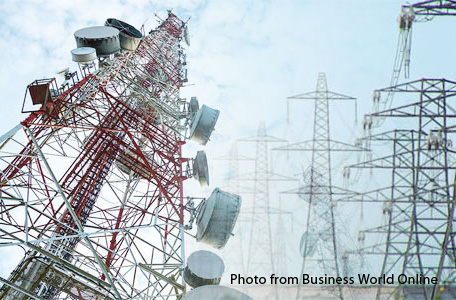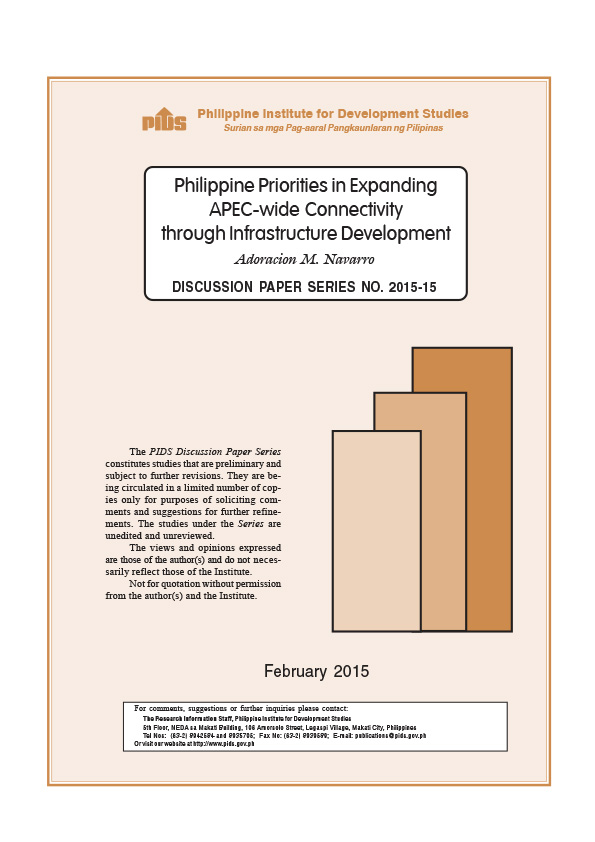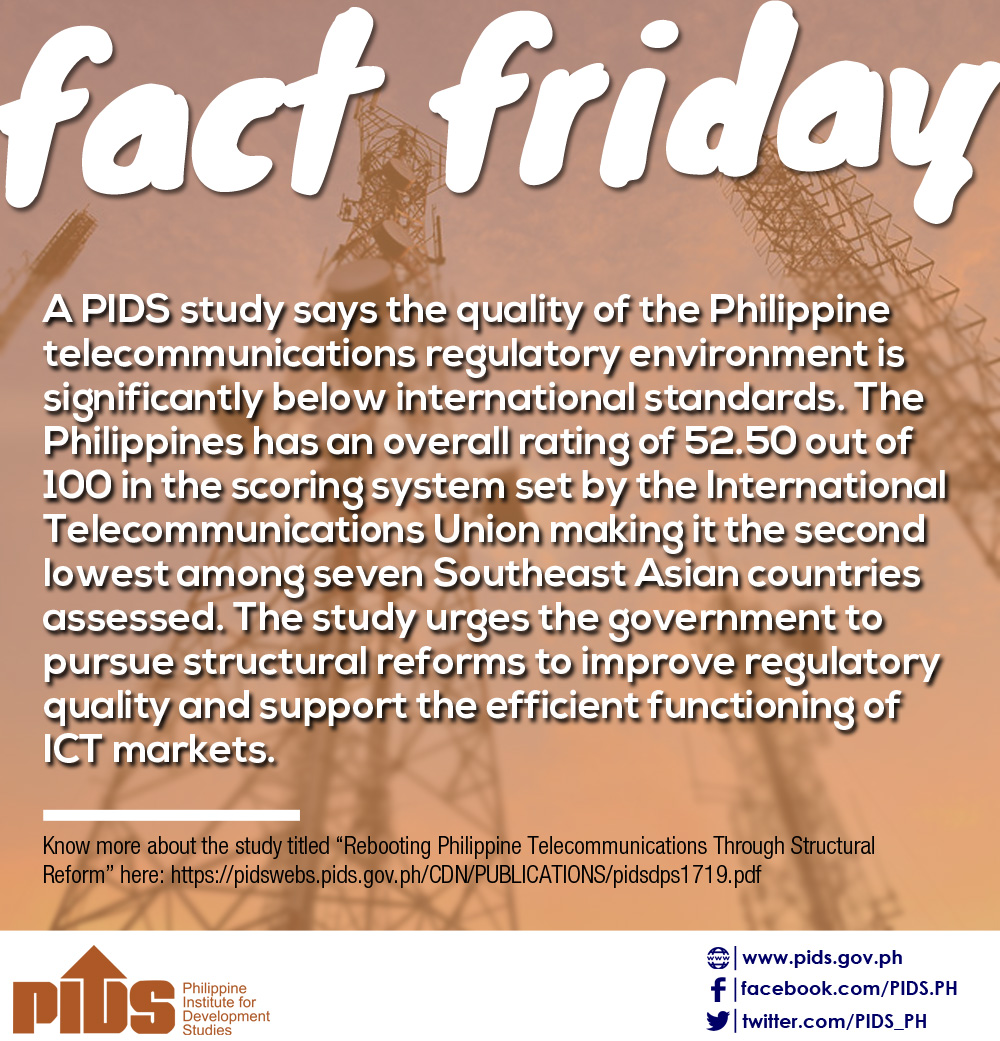
With the recent buyout of San Miguel’s telecommunication assets, only two main players are left in the telco industry – PLDT and Globe Telecom.
This move, according to Philippine Institute for Development Studies (PIDS) Senior Research Fellow Erlinda Medalla, has “brought a cloud of doubt as to the motives” of the transactions, which she said can “clearly reduce competition to just two players” in the industry.
In 2015, the Philippine Competition Act (PCA) was enacted to promote fair competition in economic activities and penalize anticompetitive conduct. Prior to this, competition policies and laws were scattered in about 30 different laws, with most of them having outdated provisions and were hardly implemented.
Medalla explained that the main purpose of the PCA is to prevent firms from unfairly obtaining market power. That is, prevent companies from unfairly excluding other firms from engaging in economic activities, which would then have the effect of lessening competition.
While the enactment of the law is a big leap, much needs to be done to establish a truly working competition policy. Case in point is the San Miguel telco acquisition, which was announced nearly a year after the PCA was enacted.
The timing (and haste) of the PLDT and Globe acquisition of the San Miguel telecommunications assets is arguably suspect, Medalla wrote in her paper.
She said the memorandum circulars, issued by the Philippine Competition Commission (PCC) while the review process was on going for the implementing rules and regulations of the Act, “provided a technical loophole for the transactions to proceed”, adding that there were concerns that the transactions may “have not been fully transparent about the terms in the co-sharing agreement and the conditions set by the National Telecommunications Commission (NTC)”.
She noted that “once a firm has obtained dominant position, it is more difficult for competition policy and law to police such firms against anti-competitive behavior.”
To counter this, she suggested to have “rules on Mergers and Acquisitions (M&A), to vet the firms against possible anti-competitive impact and make sure that the dominant position created by the M&A produces efficiency or welfare gains”.
The author also recommended that there should be at least three major players in the industry to promote competition. In the near future, however, challenges “arising from structural barriers, such as the cost of obtaining various permits and licenses (both local and national), the cost of obtaining rights of way, the available spectrum or bandwidth, and the foreign equity limitation” might make things more difficult, she pointed out.
To address this, Medalla emphasized the need for liberalization, competition, and regulatory reforms on the part of the PCC, NTC, and other government agencies, such as the National Economic and Development Authority and the Department of Information and Communications Technology.
Also, the author argued that while the acquisition by PLDT and Globe is a “done deal”, the government should make sure that this transaction benefits the consumers. Particularly, she urged government to ensure that “PLDT and Globe increase and widen their services”.
Medalla also encouraged PLDT and Globe to work with the PCC and the NTC to ensure that there is (and will be) no violation of the PCA and that the mergers and acquisitions would indeed produce benefits.
“This can be done during the transition period, where the firms can ‘cure’ any violation if any, or may request for binding ruling from the PCC. This could entail agreeing on conditions that would yield benefits for consumers, like platform sharing and interconnectivity, and increased services and greater utilization of their assets (including those newly acquired),” she added.
She also proposed that NTC and Congress reduce the barriers to entry, especially in allocating bandwidths and spectrum, and granting of telecommunications franchises, respectively, and impose stringent conditions on consumer protection and quality of service suppliers. ###
If you wish to know more about the study, download a copy of the discussion paper on the PIDS website.
This move, according to Philippine Institute for Development Studies (PIDS) Senior Research Fellow Erlinda Medalla, has “brought a cloud of doubt as to the motives” of the transactions, which she said can “clearly reduce competition to just two players” in the industry.
In 2015, the Philippine Competition Act (PCA) was enacted to promote fair competition in economic activities and penalize anticompetitive conduct. Prior to this, competition policies and laws were scattered in about 30 different laws, with most of them having outdated provisions and were hardly implemented.
Medalla explained that the main purpose of the PCA is to prevent firms from unfairly obtaining market power. That is, prevent companies from unfairly excluding other firms from engaging in economic activities, which would then have the effect of lessening competition.
While the enactment of the law is a big leap, much needs to be done to establish a truly working competition policy. Case in point is the San Miguel telco acquisition, which was announced nearly a year after the PCA was enacted.
The timing (and haste) of the PLDT and Globe acquisition of the San Miguel telecommunications assets is arguably suspect, Medalla wrote in her paper.
She said the memorandum circulars, issued by the Philippine Competition Commission (PCC) while the review process was on going for the implementing rules and regulations of the Act, “provided a technical loophole for the transactions to proceed”, adding that there were concerns that the transactions may “have not been fully transparent about the terms in the co-sharing agreement and the conditions set by the National Telecommunications Commission (NTC)”.
She noted that “once a firm has obtained dominant position, it is more difficult for competition policy and law to police such firms against anti-competitive behavior.”
To counter this, she suggested to have “rules on Mergers and Acquisitions (M&A), to vet the firms against possible anti-competitive impact and make sure that the dominant position created by the M&A produces efficiency or welfare gains”.
The author also recommended that there should be at least three major players in the industry to promote competition. In the near future, however, challenges “arising from structural barriers, such as the cost of obtaining various permits and licenses (both local and national), the cost of obtaining rights of way, the available spectrum or bandwidth, and the foreign equity limitation” might make things more difficult, she pointed out.
To address this, Medalla emphasized the need for liberalization, competition, and regulatory reforms on the part of the PCC, NTC, and other government agencies, such as the National Economic and Development Authority and the Department of Information and Communications Technology.
Also, the author argued that while the acquisition by PLDT and Globe is a “done deal”, the government should make sure that this transaction benefits the consumers. Particularly, she urged government to ensure that “PLDT and Globe increase and widen their services”.
Medalla also encouraged PLDT and Globe to work with the PCC and the NTC to ensure that there is (and will be) no violation of the PCA and that the mergers and acquisitions would indeed produce benefits.
“This can be done during the transition period, where the firms can ‘cure’ any violation if any, or may request for binding ruling from the PCC. This could entail agreeing on conditions that would yield benefits for consumers, like platform sharing and interconnectivity, and increased services and greater utilization of their assets (including those newly acquired),” she added.
She also proposed that NTC and Congress reduce the barriers to entry, especially in allocating bandwidths and spectrum, and granting of telecommunications franchises, respectively, and impose stringent conditions on consumer protection and quality of service suppliers. ###
If you wish to know more about the study, download a copy of the discussion paper on the PIDS website.












